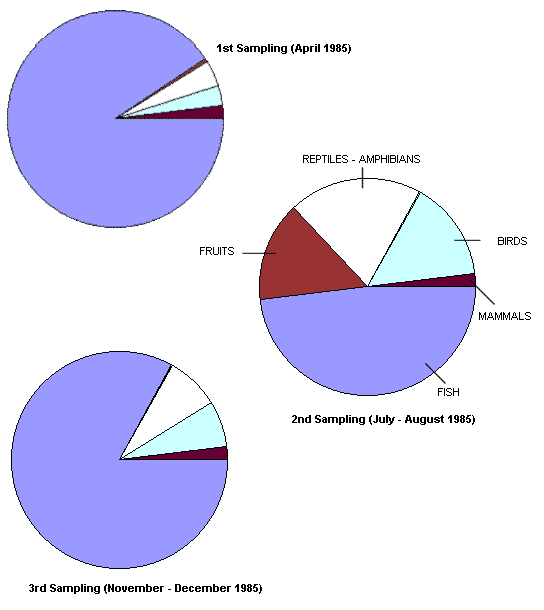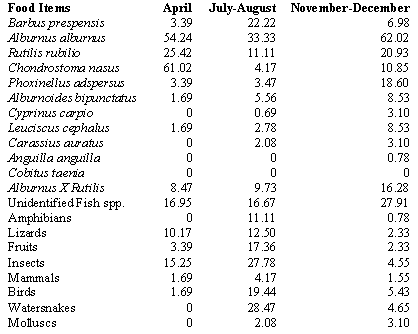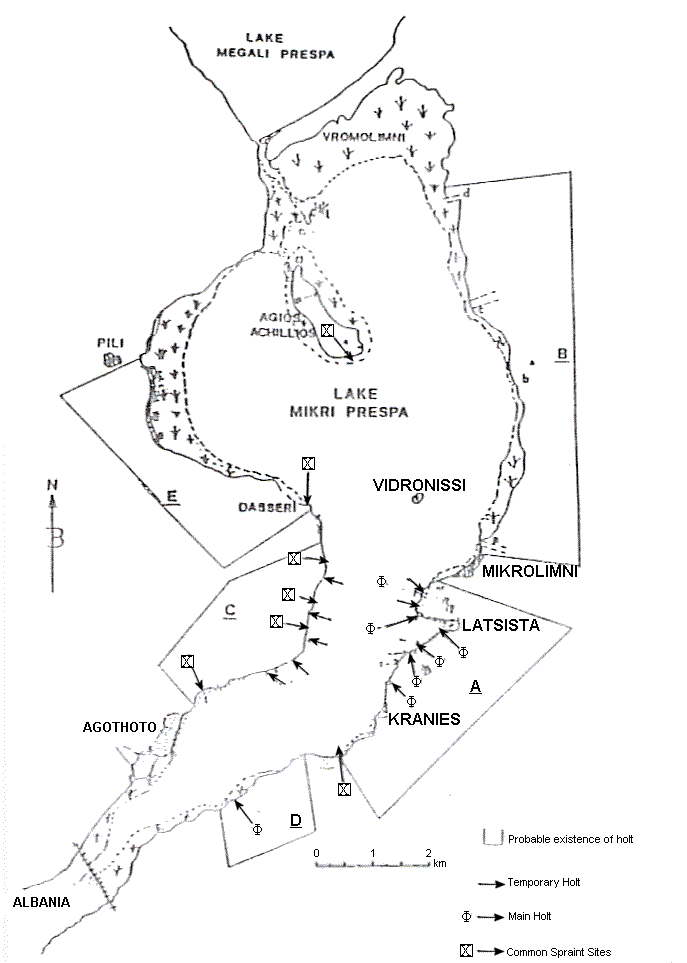 |
Last Update:
Friday November 23, 2018
|
| [Home] |
|
Volume 3 Pages 1 - 51 (March 1988) Citation: Delaki, E.-E., Kotzageorgis, G., Vassiliki, I. and Stamopoulos, A. (1988) A Study of Otters in Lake Mikri Prespa, GreeceIUCN Otter Spec. Group Bull. 3: 12 -16 A Study of Otters in Lake Mikri Prespa, Greece Evangalia-Eleni Delaki, George Kotzageorgis, Vassiliki Ioannidou and Argyria Stamopoulos 25 Kyclados Street, Agia Paraskevi, 15341 Athens, Greece. INTRODUCTION Lake Mikri Prespa is situated in north-west Greece at an altitude of 853 m. It is mesotrophic but is rapidly becoming eutrophic. The total length of shore-line is 46 km and water passes from the lake into Lake Megali Prespa. It is one of the most important wetlands in Europe for its fauna and flora and, in 1974, was declared a National Park. Our study was carried out between April 1985 and August 1986. Spraint collections were made in April, July-August and November-December 1985 and in July-August 1986. RESULTS
Cyprinidae were the most common prey items since, of the 13 species of fish found in Mikri Prespa, 10 belong to this family. Table 1 gives the percentage frequencies for each species. Fish species were taken in proportion to their relative abundance in the lake, with Alburnus alburnus, the most numerous fish, occurring most frequently in spraints. Rutilus rubilio is also common and is frequently eaten.
The occurrence of some species in the diet varied with season. For instance, the percentage frequency of Chondrostoma nasus in spring was 60% but only 4 and 10% in the summer and autumn/winter respectively. This difference may be explained by the fact that C.nasus breeds from mid-April to the end of May when they are abundant and easily caught round the rocky coasts of the lake. Most of the spraints we collected in the spring were found along the rocky shores. Barbus plebejus prepensis was similarly found commonly in spraints during its breed season (July-August). The results indicated that the otters fed mostly close inshore even though the lake has a maximum depth only 7.5 m. Most of the fish taken by otters were 10-25 cm in length. Very few large fish like Cyprinus carpio, Leuciscus cephalus or Carassius auratus gibelio were eaten. Anguilla anguilla was almost absent from the diet but we have little information on eel populations in the lake. When schooling species such as Alburnus or Phoxinellus adspersus were the prey, then the remains of more than one individual (often 2-4) were usually found in each spraint. As can be seen from Table 1, water snakes (Natrix
natrix and N. tesselata) and birds (mostly Fulica atra) were
important components of the food during the summer. Surprisingly, fruit was also
eaten in the summer, especially fruits of Cornus mas, C. sanguinea
and Prunus mahaleb.
In area A two main holts, thought to be used for breeding, were found 800m apart. Both were marked with large accumulations of spraints. These holts comprised large caves with several entrances and intercommunicating chambers and were protected behind by 10m vertical rock faces. The holts were located close to rich inshore feeding areas. Thirteen other lying-up sites (temporary holts) were identified mostly in simply shaped rock caves, reed beds or amongst tree roots. In the proximity of holts or lying-up places the number of spraints found increased. In area C, high numbers of spraints were also found mid-way between neighbouring lying-up sites. It is thought that the otters were not territorial except perhaps for the males during the mating period (early winter). Females with cubs do, however, appear to have priority in choice of range. The availability of shelter provided by vegetation or rocks appears to be a significant factor in determining which areas are used by the animals. Phragmites, Rubra and Rosa are important for cover as are fig and oak trees. Twenty years ago otters were frequently seen by the local people and fishermen on the lake. Today this is rare. The decline seems to have occurred largely within the last ten years although food availability has not changed. Evidence suggests that the otter population is well below the potential carrying capacity. It is suggested that the misuse of fertilizers and pesticides may be to blame and that the resulting levels of pollution together with increased human disturbance have led to a decline which may well prove irreversible. |
| [Copyright © 2006 - 2050 IUCN/SSC OSG] | [Home] | [Contact Us] |


